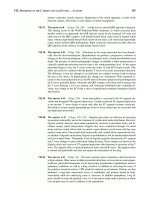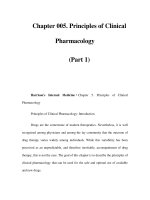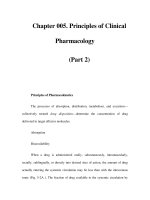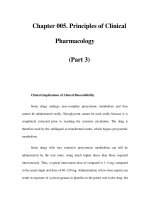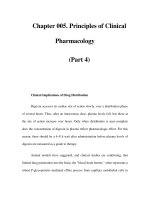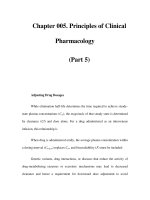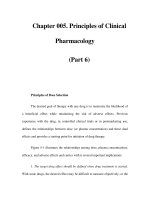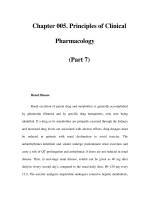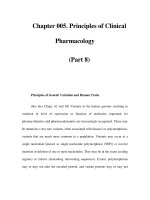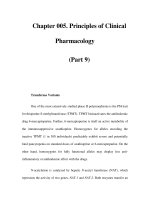Chapter 081. Principles of Cancer Treatment (Part 5) ppt
Bạn đang xem bản rút gọn của tài liệu. Xem và tải ngay bản đầy đủ của tài liệu tại đây (13.95 KB, 5 trang )
Chapter 081. Principles of
Cancer Treatment
(Part 5)
Although radiation can interfere with many cellular processes, many
experts feel that a cell must undergo a double-strand DNA break from radiation in
order to be killed. The factors that influence tumor cell killing include the D
0
of
the tumor (the dose required to deliver an average of one lethal hit to all the cells
in a population), the D
q
of the tumor (the threshold dose—a measure of the cell's
ability to repair sublethal damage), hypoxia, tumor mass, growth fraction, and cell
cycle time and phase (cells in late G
1
and S are more resistant). Rate of clinical
response is not predictive; some cells do not die after radiation exposure until they
attempt to replicate.
Therapeutic radiation is delivered in three ways: (1) teletherapy, with
beams of radiation generated at a distance and aimed at the tumor within the
patient; (2) brachytherapy, with encapsulated sources of radiation implanted
directly into or adjacent to tumor tissues; and (3) systemic therapy, with
radionuclides targeted in some fashion to a site of tumor. Teletherapy is the most
commonly used form of radiation therapy.
Radiation from any source decreases in intensity as a function of the square
of the distance from the source (inverse square law). Thus, if the radiation source
is 5 cm above the skin surface and the tumor is 5 cm below the skin surface, the
intensity of radiation in the tumor will be 5
2
/10
2
, or 25% of the intensity at the
skin. By contrast, if the radiation source is moved to 100 cm from the patient, the
intensity of radiation in the tumor will be 100
2
/105
2
, or 91% of the intensity at the
skin. Teletherapy maintains intensity over a larger volume of target tissue by
increasing the source-to-surface distance. In brachytherapy, the source-to-surface
distance is small; thus, the effective treatment volume is small.
X-rays and gamma rays are the forms of radiation most commonly used to
treat cancer. They are both electromagnetic, nonparticulate waves that cause the
ejection of an orbital electron when absorbed. This orbital electron ejection is
called ionization. X-rays are generated by linear accelerators; gamma rays are
generated from decay of atomic nuclei in radioisotopes such as cobalt and radium.
These waves behave biologically as packets of energy, called photons. Particulate
forms of radiation are also used in certain circumstances. Electron beams have a
very low tissue penetrance and are used to treat skin conditions such as mycosis
fungoides. Neutron beams may be somewhat more effective than x-rays in treating
salivary gland tumors. However, aside from these specialized uses, particulate
forms of radiation such as neutrons, protons, and negative mesons, which should
do more tissue damage because of their higher linear energy transfer and be less
dependent on oxygen, have not yet found wide applicability to cancer treatment.
A number of parameters influence the damage done to tissue by radiation.
Hypoxic cells are relatively resistant. Nondividing cells are more resistant than
dividing cells. In addition to these biologic parameters, physical parameters of the
radiation are also crucial. The energy of the radiation determines its ability to
penetrate tissue. Low-energy orthovoltage beams (150–400 kV) scatter when they
strike the body, much like light diffuses when it strikes particles in the air. Such
beams result in more damage to adjacent normal tissues and less radiation
delivered to the tumor. Megavoltage radiation (>1 MeV) has very low lateral
scatter; this produces a skin-sparing effect, more homogeneous distribution of the
radiation energy, and greater deposit of the energy in the tumor, or target volume.
The tissues that the beam passes through to get to the tumor are called the transit
volume. The maximum dose in the target volume is often the cause of
complications to tissues in the transit volume, and the minimum dose in the target
volume influences the likelihood of tumor recurrence. Dose homogeneity in the
target volume is the goal.
Radiation is quantitated on the basis of the amount of radiation absorbed in
the patient; it is not based on the amount of radiation generated by the machine.
The rad (radiation absorbed dose) is defined as 100 erg of energy per gram of
tissue. The International System (SI) unit for rad is the Gray (Gy); 1 Gy = 100 rad.
Radiation dose is measured by placing detectors at the body surface or calculating
the dose based on radiating phantoms that resemble human form and substance.
Radiation dose has three determinants: total absorbed dose, number of fractions,
and time. A frequent error is to omit the number of fractions and the duration of
treatment. This is analogous to saying that a runner completed a race in 20 s;
without knowing how far he or she ran, the result is difficult to interpret. The time
could be very good for a 200-m race or very poor for a 100-m race. Thus, a typical
course of radiation therapy should be described as 4500 cGy delivered to a
particular target (e.g., mediastinum) over 5 weeks in 180-cGy fractions. Most
curative radiation treatment programs are delivered once a day, 5 days a week in
150- to 200-cGy fractions.
Compounds that incorporate into DNA and alter its stereochemistry (e.g.,
halogenated pyrimidines, cisplatin) augment radiation effects. Hydroxyurea,
another DNA synthesis inhibitor, also potentiates radiation effects. Compounds
that deplete thiols (e.g., buthionine sulfoximine) can also augment radiation
effects. Hypoxia is a major factor that interferes with radiation effects.
